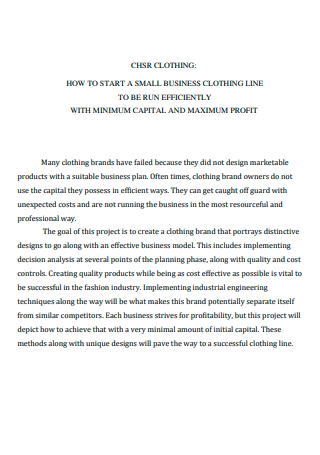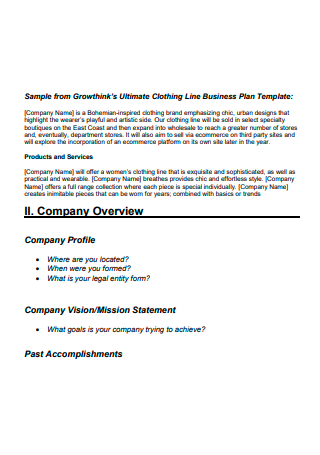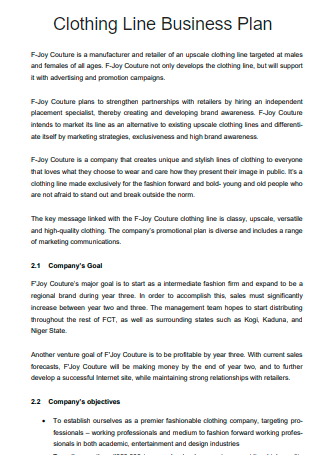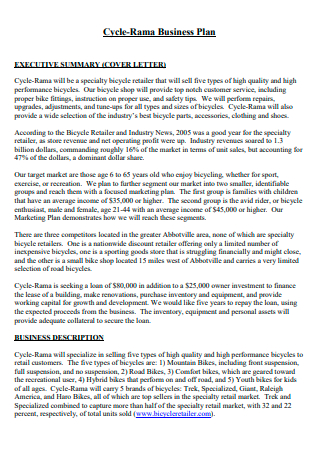3+ Sample Clothing Line Business Plan
FREE Clothing Line Business Plan s to Download
3+ Sample Clothing Line Business Plan
Clothing Line Business Plan: What Is It?
The Different Facets of Fashion Design
How To Make a Clothing Line Business Plan
FAQs
How profitable is a clothing line business?
What are ready-to-wear clothes?
What are the legal requirements to start a clothing business?
What are other barriers to entry into a clothing business?
What are some of the tips when starting a clothing line?
Clothing Line Business Plan: What Is It?
Let’s start by defining what a clothing line is. A clothing line is all of the clothing or apparel produced by a fashion group or company. A clothing line is usually designed for a specific target market. Clothing line designs range from casual to formal wear, from party to sportswear. Oftentimes, the clothing line is used interchangeably with the phrase clothing collection. A clothing collection is a set of designs produced for a particular season. Hence, a clothing collection is found within a clothing line. Now moving on to the clothing line business plan definition. A clothing line business plan is a roadmap, a guide for establishing and solidifying the clothing line business in the fashion industry. Since the clothing, apparel, or fashion industry is a business per se, just like all business trade, a clothing line business should have a guide in setting itself up in the market, either to ward off competition, to be a big name in the fashion world, or just to be financially successful. Hence, its tool for thriving and flourishing within the trade is an effective clothing line business plan.
The Different Facets of Fashion Design
You have your dresses, jeans, shirts, skirts, shoes, slip-on, et cetera. Any kind of textile, clothing or apparel you put on is a product of fashion design. You might be into trendy outfits, casual wear, the high fashion runway get up, all of them are grouped according to the lifestyle in which they were designed in the first place. There are many types of fashion designs that clothing lines are based on. Even though the fashion world requirements keep on changing almost on an overnight basis, still, it all boils down to the simple, basic design facets on which fashion revolves on.
How To Make a Clothing Line Business Plan
To be able to make it in the fashion business, a clothing line business must be armed with a good business plan. A clothing line business plan should lay out the action plans when it comes to the marketing, financial, and operational aspects of the business. It provides the direction in which the company is moving towards, and at times it also serves as a motivating, call-to-action for the employees to help the business grow. Business plans are also used to attract potential investors. In the case of a clothing line business plan, if it’s well-researched, well-planned, and well-written, not only is it likely to attract investors, it can also attract high-end clients. A clothing line business plan can be written in different formats. But what makes it effective is the inclusion of the following essential elements.
-
1. Executive Summary
The executive summary of a clothing line business plan gives an overview or a summary of the business plan’s content. It prepares the reader for what’s coming up in the business plan presentation, that’s why the executive summary from the start must be short, yet concise and catchy enough to appeal to the reader to read the rest of the business plan’s content. The executive summary also points out the need and opportunity for the business that is presented. Most executive summaries also contain the mission and vision statement. A mission statement explains the purpose of the business’s existence. It is also a representation of the company’s culture and values. The mission statement describes what the company does and the values or services it brings to its clients or customers. In turn, a vision statement provides a depiction of what the business will look like in a given time. It is the call-to-action, motivating statement of the executive summary. The vision statement sets the overall tone and direction for the marketing and sales strategy of the business plan. Similarly written as business objectives, a vision statement is also reflective of the company’s goals that should be specific, measurable, achievable, relevant, and time-bound, or also known as the SMART goals.
-
2. Market Analysis
A clothing line business market analysis takes a look at the market condition in which the business will be set up. It identifies the target market, and it also assesses if there is a need or a market opportunity, or a niche for the kind of clothing line the business is in. The best way to do a market analysis is first to establish the target market through demographics or doing customer segmentation. The targeted customers are classified according to age, gender, lifestyle, income, location, et cetera. Next is to identify existing competition. The information taken out from researching your competition is useful later on when doing marketing and sales strategies. Pointing out barriers to entry in the market is also another way of doing market analysis. Barriers to entry are those factors that prevent your clothing line business from penetrating the fashion industry. Doing SWOT analysis is also another way of doing market analysis. SWOT analysis in a clothing line business plan means Strength of the business, or what makes your clothing line unique, appealing, and stands out from your competitors; Weaknesses are those factors that hinder the growth of the clothing line business, such as weak company branding, weak fashion designs, lack of resources, et cetera.; Opportunities are the factors that the business could take advantage of to grow, such as marketing through social media platforms, hiring influencers or celebrities to endorse the company brand and many more; Threats are those aspects that could potentially bring risk or harm to the business operation, such as the increased presence of competition, increased costs of materials, such as textiles and other accessory parts, increased cost of labor, and so on.
-
3. Identifying the Clothing Line, Designs, and Brand
What makes a clothing line business stand out is, of course, its line of fashion design. Hence, an essential element of a clothing line business plan is identifying the business’s unique clothing line and design. It could be in the form of recognizable and appealing color combinations, unique cuts and style, or a unique textile quality. This is the part where you also describe your business’s brand. A clothing line business brand should be designed in a way that appeals to your target market. It should also reflect the company’s personality, culture, and values.
-
4. Marketing and Sales Strategies
A clothing line business marketing strategy should be designed to reach prospective clients and turn them into real, paying customers. A marketing strategy is the communication action plans that the business utilizes to penetrate the market, or is all about positioning the business in the market. Examples of clothing line marketing strategies could be social media marketing, content marketing through blog and vlog posts, event sponsoring, brand ambassadors, or even marketing through traditional media channels, such TV and radio, and even billboard posts and magazines featured article write-ups. Sales strategy is all about selling and increasing sales revenue. Oftentimes, sales strategies revolve around the four P’s: product, placing, pricing, and promotion. Product in a clothing line business refers to the produced apparel or fashion designs of the company. Placing refers to how the clothing line is placed in the market, such as physical retail stores, online stores, fashion shows, and displays, et cetera. Pricing is the cost of purchase for particular clothing apparel or fashion design. Promotion deals with advertising and public relations campaign strategies.
-
5. Financial Planning
Financial planning involves assessing the financial condition of the business, making a forecast, and determining the best ways of utilizing the business’s financial resources through identified marketing and sales strategies. A typical financial planning section in a business plan includes either a cash flow statement, balance sheet, or a sales forecast. A cash flow statement is your capital or budget versus expenses calculation. A balance sheet is your assets, liabilities, and equities computation. While a sales forecast is your sales revenue projection in a particular time frame.
FAQs
How profitable is a clothing line business?
A clothing line business success and profitability largely depends on how appealing the apparels and fashion designs are to the target market. If the designs are trending and popular enough, you can be able to see massive profits in your business. Like all kinds of business, profitability would also depend on the production volume. Always note that profit is the net financial gain, the total of the revenue earned less the expenses. To realize a profit, it is best to always balance the production volume together with the marketing and sales strategy and to make sure that operation and production expenses are well-controlled.
What are ready-to-wear clothes?
Ready-to-wear, also known as RTW or off-the-rack, are pre-manufactured clothes produced and in standard sizes and finished condition. Ready-to-wear clothes are often labor-intensive and mass-market produced, saving the business more time and money in clothing production.
What are the legal requirements to start a clothing business?
The legal requirements of a clothing business are also similar to any other type of business legal requirements. First off is to form a legal entity for the business structure. It could be in the form of a sole proprietorship, limited liability company (LLC), partnership, or corporation. Next is registering the business for tax. The tax could vary depending on the state or federal tax available within the jurisdiction. The next thing to do is get the necessary permits and licenses. Same as with taxes, permits and licenses would vary from state to state, or from city to city, et cetera, depending upon the business’s location. Also, don’t forget to obtain a trademark and copyright protection for your brand’s or fashion design’s unique concept as necessary. Last but not the least, obtain business insurance as financial protection for your business in the event of damage or loss.
What are other barriers to entry into a clothing business?
Barriers to entry are those factors that obstruct or hinder a business from penetrating the market economy. Some of the barriers to entry in a clothing business include a congested market, meaning, lots of existing competition in the area or competing brands; expense startup cost or capital; strict government regulation; lack of or inaccessibility of resources or supply chain; location or geographical barriers; brand loyalty; cost and pricing disadvantages, such as predatory pricing; or distribution network barriers.
What are some of the tips when starting a clothing line?
Entering the fashion industry is a tricky business. You’ve got to know what’s in or out, what’s hot or not in the business. To be recognizable, you need to have your unique brand concept, or unique clothing line concept. One way to do that is to improve your skills through training and research. Look into how fashion masterminds come up with their concepts as a source of your inspiration. Train thoroughly and learn or relearn new skills. Learn about the latest skills or techniques when it comes to clothing manufacturing or production. Enrolling in fashion courses or schools would be a good idea. Another way is to navigate through the latest fashion, keeping yourself updated with the latest trends. Make connections with clothing or textile manufacturers. When it comes to launching your clothing line, make sure that you time your fashion display or launch appropriately according to the fashion season.
The fashion world is unstoppable. There’s no stopping the fashion industry’s geniuses from coming out with the latest trends year in and year out, season by season. Even the pandemic was unsuccessful in putting a halt to the creative minds that manage to turn what seemed to be a disadvantage into a blooming advantage when it comes to fashion trends. Think of fashionable, vibrant, eye-catching trendy face masks. Think of colorful and attractive PPE (personal protective equipment) gears or uniforms. And when it comes to fashion and clothing success, all you need to have in hand is a good and effective clothing line business plan.
Our clothing line business plan templates are ready-drafted, accessible, and easy to fill out. If you’re ready to start your very own clothing line business, download our template, and start building and gearing up your own fashion business for success!




